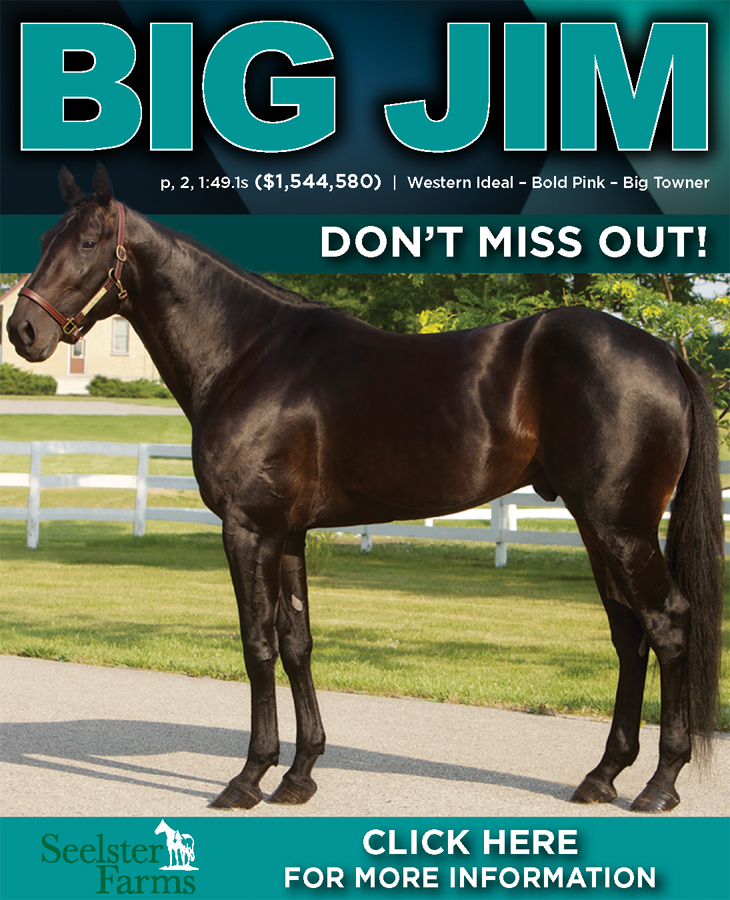

Knead to Know
How to succeed in breeding and selling your own yearling.
by Trey Nosrac
Peter Remington, Esq., scheduled an emergency meeting of the Remington/Nosrac Harness Horse Corporation at the Knead to Know Bagel and Coffee Emporium. Peter was already seated with a cup of tea when I arrived.
Peter is a gangly 6’5” but does not appear tall due to a constant slouch. A basically good looking guy in his mid-thirties, for some reason this morning, my former college roommate sported a tweed jacket, slicked back hair and comically over-sized black glasses. Peter rapped his knuckles on the wooden table to call the meeting to order.
“Trey, my good man, I may have led you astray.”
I always get a kick out of it when Peter speaks like an aristocrat from Masterpiece Theater. When he shifts into masterpiece mode, he usually has something up his sleeve; something strange, that I will aid and abet.
Channeling Winston Churchill, I endeavored to play my part.
“My assumption is the term astray refers to our romp into the field of breeding a harness racehorse. Does this venture continue to hit bumps in the road?”
“Not bumps Trey, more like mountains with large crevasses on the other side. Our well laid plan of spending $15,000 to produce a yearling and having at least two interested parties drive the purchase price up to the neighborhood of $30,000 now appears as likely as the Tory Party sweeping the next election.”
Buttering a croissant the size of a tennis shoe, I tried to recall the fate of the Tory party as I formulated my next question.
“Remind me how we arrived at this unfortunate point.”
Peter placed his hands together prayerfully and said, “After several years of attending horse sales and spending money to little avail, we marveled at how the occasional yearling was purchased for a substantial amount of money. Our plan was, ‘Let’s sell instead of buy.’”
I nodded, “Ah, yes.”
“My good Trey, you may recall we jotted down a list of considerations. Did we own a farm (No)? Did we have any experience in the business of breeding horses (No)? Did we have a stallion (No)? Did we have a blue-blooded mare (No)? Did we have a stash of disposable income (No)? Did we have anything that recommended this was a good venture (No)?”
I nodded and then replied, “Of course, how could I forget? You convinced me that a long list of no’s was the signal to begin this breeding madness, at which point we began to borrow money at a furious rate.”
Peter continued, “Indeed, perhaps we missed a few signs, but let us return to today’s equine business and report that The Black Book appeared online today; there are 1,297 yearlings catalogued for sale; our lone entry is HIP number 1267. This means our filly will stroll onto the stage when buyers will likely be out of money, out of patience, on their way out of town or in a stupor. Our situation is dire. Lassie Chatterley was once a small fish in a big pond, now she is a minnow, perhaps plankton.”
“That bad?”
“Worse than being slightly undersized is that slight lump on her knee that is a bayonet thrust to the stomach with the catalogue placement being the full evisceration.”
“Well, we can always bring her home and race her.”
He sighed deeply and wagged his head, “Trey, Trey, Trey, if you recall …this breeding adventure was a reprieve from our lengthy run of unproductive adventures in racing. Not to be catty, but your exact words were, ‘It has to be a heck of a lot easier to make money selling these things than racing them.”
I said, “Well, this is what happens when you listen to me.”
“Water over the dam my good man. Chin up, forward ho, once again into the breach. Let us spin gold from flax.”
“I hope that gibberish translates into a plan.”
“Perhaps… our yearling has some assets. The young steed will enter the sales ring with four legs and a tail. Alas, we have the previously mentioned deficits. We do not stand out from thousands of yearlings heading for the marketplace.”
“This is very un-Peter-like, showing a flair for the obvious and offering no insight.”
“Patience my good man — all will be revealed.”
Opening my arms, I said “Proceed.”
“We must create Lassie Chatterley lovers. We must spread the word to any and all potential buyers. The assets of HIP #1267 must be trumpeted. We will stoop to any level, including advertising, driving potential customers to the sales arena in a gilded chariot or threatening to expose dark family skeletons unless feverish bidding takes place when Lassie Chatterley performs her short dance on the stage.”
“Tis a fine plan my lanky friend. Alas, I see some flaws.”
Peter replied, “Yes, yes, the chariot and extortion concepts are a tad extreme.”
“No, I am referring to the world of advertising, a tricky game where the costs are high, the results are difficult to measure and with a single yearling to offer, we face the economy of scale. We are already facing a deep fiscal hole with this breeding madness; adding an advertising budget may be handing matchsticks to two men already on fire.”
“Trey, pessimism does not become you.”
“Nor does sitting in a Prius for Lyft for the rest of my life.”
Peter took another slug of coffee, leaned back and began once again to make madness seem mundane. This is what draws me to the guy.
He said, “We shall try a dab in print media, it still has a bit of steam, but most of our efforts will be digital. After all, our age demographics and digital fluency place us in the new wave of harness horse enthusiasts.”
I replied, “Perhaps we are not the new wave but rather the last ripple. Come to think of it, what if we just wait until we reach age 40, at that point we may be the only ones still alive in the harness horse breeding business. There will be far less competition.”
“Trey, as promising as that sounds it is a tad late to be coming up with new plans. Let us return to the fate of Lassie Chatterley and her beleaguered owners. I have done some homework. Ads in digital publications such as HRU are quite inexpensive, plus the content can be tailored and timely. And social media is free and free is a good price point.”
“Continue.”
“Instead of sitting around fretting, we will build a database of trainers, old owners, new owners, potential owners, wealthy relatives, and moguls looking for tax shelters — anyone who might possibly raise a hand when Lassie Chatterley is in the ring. We should contact as many people as possible with as many angles as possible.”
“Peter, this all seems a bit desperate and quite pathetic. Many of the people we approach will resent our efforts and find the process pushy. It feels sort of… oh, tawdry.”
“Desperate, pathetic and tawdry has the ring of a firm of lawyers once allied against me. Alas, old chap, this is where we are. Really, my good man, it’s old-fashioned marketing. After all, Lassie Chatterley is more promising than many horses in that sale.”
“Well, I suppose this is an alternative to doing nothing. It is not a good alternative, just sort of an exotic remedy for an exotic illness.”
“Trey, our fascination with this sport may well be an exotic illness, but we do enjoy the twists and turns with the trotters and pacers. Besides, people face this dilemma in the real world every day. If we do nothing, our filly is like a starlet waiting to be discovered in a very long casting line. We shall become agents for Lassie Chatterley. We need to do all we can to get her, if not on Broadway, at least in community theater.”
I raised my fist in triumph and smiled, “I see the plan clearly now. We enter the worlds of advertising and promotion, fields where we have less knowledge and less experience than breeding horses. What could possibly go wrong?”
“We shall soon see.”















